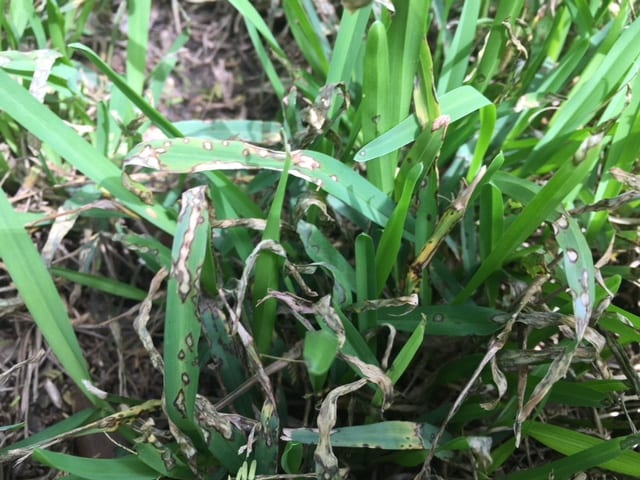Chances are if you’ve suffered from lawn fungus damage in the past and it went untreated, it will most likely rear it’s ugly head back up again. Remember that lawn fungus prevention along with a consistent fertilization schedule will be your best defense against most turf problems. ( It’s always best to bring in samples and/or pictures so we can help you clearly diagnose the issue you are experiencing with your turf, but the following are common lawn fungus issues we experience here in San Antonio.)
4 Common San Antonio Lawn Fungus Problems
1. Take-All Root Rot Lawn Fungus (TARR)
- Lawn Fungus Occurs: late March – May (not a hot weather disease)
- Lawn Fungus Symptoms: TARR is a major disease problem in St. Augustine that grass causes leaf tissue to turn yellow and pull loose from runner (similar to grub damage, except no grubs present in soil.) In affected areas of lawn, you might find both green and yellow leaf blades. Close examination (may need magnification) of the runners will reveal short, dark-brown to black roots.
- Lawn Fungus Treatment: If TARR is the problem, then an application of sphagnum peat moss is one of the best treatments for this disease problem (fungicides rarely work). Apply approximately 1 to 2 bales of the peat moss per 1,000 sq. ft. to the affected areas of the lawn and thoroughly soak the peat moss until it is wet. We have seen better results from a topdressing with peat moss than we have with the application of any fungicide in most cases. Repeat peat moss application a year or two later as needed.
2. Slime Mold Lawn Fungus
- Lawn Fungus Occurs: June-August
- Lawn Fungus Symptoms: Slime mold presents itself as patches of grass, about hand-size, that appear to have cigarette ashes sprinkled on them. No harmful damage, except perhaps a little shading of the areas affected.
- Lawn Fungus Treatment: You can hose off the spores, brush them off with your shoe, or mow to remove them.
3. Gray Leaf Spot Lawn Fungus
- Lawn Fungus Occurs: June- early September
- Lawn Fungus Symptoms: Watch out for gray-brown, blotchy to diamond -shaped lesions on the grass blades (mostly on St. Augustine lawns). If you see this on your lawn, think back to if you just applied nitrogen to the turf through the summer, because you saw yellowed-leaves. You might have thought your turf needed more nitrogen, but in fact, the application of extra nitrogen could have increased likelihood of fungus.
- Lawn Fungus Treatments: Systemics fungicides like Fertilome F-Stop, Bonide Infuse, Bayer Advanced Fungus Control, can help, but also refrain from applying nitrogen fertilizers from summer until cool fall temps.
4. Brown Patch Lawn Fungus
- Lawn Fungus Occurs: Usually in mid September – mid November (but we’ve seen it in spring!)
- Lawn Fungus Symptoms: Look for 18-24 inch yellowing, irregular patches that quickly turn brown. These patches may merge into each other. Infected blades of grass will pull easily from runners, and you will see the left over, decayed leaf blade attached to runner.
*To avoid the dreaded Brown Patch fungal disease, make sure you are not watering at night especially during these cooler months. Do not put your lawn to bed wet! - Lawn Fungus Treatment: Treat with a systemic lawn fungicide like: Fertilome F-Stop, Bonide Infuse, Bayer Advanced Fungus Control. If brown patch has been a recurring lawn fungus in your turf, you might opt to treat with fungicides as a preventative when conditions are favorable for disease and before disease symptoms are apparent. (cooler weather, excessive rain/humidity).
*Horticultural cornmeal is an organic alternative preventative/treatment to battle lawn fungus, as is the peat moss mentioned in the TARR section. The cornmeal must be “horticultural grade” not what you use to make Grandma’s cornbread. Also, don’t get it confused with “corn gluten” which is used as an organic weed pre-emergent.
Hope this information will help you enjoy a fungus free lawn each season!
~The Happy Gardener, Lisa Mulroy


Does natures Choice fungicide with cornmeal work?
Do you mean Nature’s Creation? We have had some customers who have come in and love the results they have gotten, while others don’t find that it gives them the results they needed. It kind of gives a mixed bag of results, and takes longer to address the fungus than say, a synthetic option.